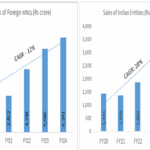New Delhi, January 31st, 2018 : Leprosy is a chronic infectious disease caused by Mycobacterium leprae. It usually affects the skin and peripheral nerves, but has a wide range of clinical manifestations. The disease is characterized by long incubation period generally 5-7 years and is classified as paucibacillary or mulitbacillary, depending on the bacillary load. Leprosy is a leading cause of permanent physical disability. Timely diagnosis and treatment of cases, before nerve damage has occurred, is the most effective way of preventing disability due to leprosy.
The country achieved the goal of elimination of leprosy as a public health problem, defined as less than 1 case per 10,000 population, at the National Level in the month of December, 2005. As on 31st December 2005, Prevalence Rate recorded in the country was 0.95/10,000 population.
Q 1. What is Leprosy?
Leprosy is a long persisting (chronic) infectious disease.
It appears as a hypo-pigmented patch on skin with definite loss of sensation. The onset of leprosy is subtle and silent. It affects nerves, skin and eyes.
Of all the communicable diseases, leprosy is very important for its potential cause for permanent and progressive physical disability.
Q 2. What causes Leprosy?
Leprosy is caused by bacteria (Mycobacterium leprae.)
Q 3. How is the disease spread?
Untreated leprosy-affected person is the only known source for transmission of the bacteria. Respiratory tract, especially nose, is the major route of exit of the organism from the body of infectious persons.
Disease causing organism enters the body commonly through respiratory system by droplet infections.
After entering the body, the organism migrates towards the nerves and skin.
If it is not diagnosed and treated in early stages, it may cause further damage to nerves leading to development of permanent disability.
Q 4. Is the disease hereditary?
There is no evidence to say that it is hereditary.
Q 5. What are the signs and symptoms of leprosy?
Leprosy should be suspected if a person shows the following signs and symptoms: Dark-skinned people might have light patches on the skin, while pale-skinned people have darker or reddish patches, Loss or decrease of sensation in the skin patches, Numbness or tingling in hand or feet, Weakness of hands, feet or eyelids, Painful nerves, Swelling or lumps in the face or earlobes, Painless wounds or burns on hands or feet.
Q 6. Is Leprosy curable?
The disease is curable. If detected early it can be cured by Multi-Drug Therapy (MDT)
Recurrence after adequate treatment with MDT is extremely rare.
Q 7. Why leprosy takes so long to show symptoms?
The symptoms of the disease occur generally after a long period as the incubation period for leprosy is variable from few weeks to 20 years or more. · The average incubation period of the disease is said to be five to seven years.
Q 8. What should be done in case of suspicion of leprosy?
In case of presence of signs and symptoms of leprosy, please contact ASHA or ANM of your area or visit the nearest dispensary. Treatment of leprosy is available free of cost at all government dispensaries.
Q 9. What is the impact (medical) of leprosy?
It results in physical disability and deformity due to nerve damage resulting in sensory and muscle weakness.
All this leads to dry skin – that with added sensory impairments, results in development of hardened skin, blisters and ulcers.
If ulcer is neglected, it may further worsen the disability. This is compounded by muscle paralysis leading to deformity.
Q 10. Where is the medicine for leprosy available?
MDT is available free of cost at all the Government Health Care Facilities in the country. Under the National Leprosy Eradication Programme, treatment is provided free of cost to all the cases diagnosed each year through the general health care system including NGO institutions.
Q 11. Can the deformities be corrected by medicine?
No, but can be prevented by early detection and treatment.
Medicines (MDT) should be started as soon as possible after the person is diagnosed as having leprosy. Those who start the MDT late, after irreversible loss of nerve functions, are left with deformities and become disabled physically. Such deformities can be corrected to a limited extent only with surgery.
Q 12. Can the deformity be corrected by surgery?
Only partial deformity can be corrected by surgery.
Q13. How to prevent disability?
Detect cases as early as possible, before deformities can set in.
It is therefore important to take regular treatment (MDT), report immediately in case of loss of sensation or nerve pain.
Q14. Should a person affected by leprosy be sent to a leprosy sanatorium?
There is no need to treat leprosy patients in special clinics or hospitals. In many countries, leprosaria have been transformed into general hospitals or other functions.
Q15. Can I live with a person affected by leprosy?
Yes, you can live with a person affected by leprosy because it is not highly infectious. People affected by leprosy should not be isolated from their family and community. They can take part in social events and go to work or school as normal.
Q 16. Can a person affected by leprosy get married?
Yes, a person affected by leprosy can lead a normal married life and have children.
Q 17. Is it necessary to examine those in contact with a person affected by leprosy?
Those who live with a person affected by leprosy are at increased risk of getting the disease. Therefore, it is important to have people living in the same household and close friends examined regularly for leprosy. At the same time, they should also be educated regarding the signs and symptoms of leprosy as well as the type of help they can give to the leprosy patient living with them.
Q18. What should One know about MDT?
MDT is a combination of different drugs as leprosy should never be treated with any single anti-leprosy drug.
One should complete the full course of MDT as prescribed by a trained health worker according to the type of leprosy.
MDT is available free of charge at most health facilities including in remote areas.
Any adverse reaction to MDT should be reported to the nearest health facilities.
Q 19. What if a leprosy patient cannot complete a prescribed course of MDT treatment?
It is important to understand that a leprosy patient must complete a full course of MDT. However, there are circumstances where a patient is forced to stop the treatment. In case, the patient has to move out from the place where he/she lives, the following actions are advised:
Request for a referral letter from the health care centre where he/she is currently taking the treatment. The letter should contain reports pertinent to his/her diagnosis and treatment.
Request from the same healthcare centre for sufficient MDT stock to ensure continuous treatment before he/she reports to the nearest healthcare centre in his/her new place. All health care centres can provide leprosy treatment and care.
Identify and report to the nearest healthcare centre in his/her new place by showing the referral letter; inform the new health care centre about new address in detail including contact no., if appropriate.
Q20. What are the adverse drug reactions with MDT?
MDT is remarkably safe, and severe adverse reactions are rare. Minor adverse drug reactions include: · Rifampicin: reddish urine · Dapsone: anemia · Clofazimine: brown discolouration of skin
Q 21. Is MDT safe during pregnancy and lactation for the mother and the baby?
Yes.
Q22. What is a relapse?
A relapse is defined as the reoccurrence of the disease at any time after the completion of a full course of MDT. Relapse is diagnosed by the appearance of definite new skin lesions.
Q 23. What is leprosy reaction?
Leprosy reaction is the sudden appearance of symptoms and signs of inflammation in the skin of a person with leprosy in the forms of redness, swelling, pain, and sometimes tenderness of the skin lesion. New skin lesions can also appear. Leprosy reaction can occur before, during and after completion of treatment. In case of leprosy reaction, report back to your nearest dispensary.
Q24. What is the current focus of the program?
Early detection of all cases in a community and completion of prescribed treatment using MDT are the basic tenets of the Enhanced Global Strategy for Further Reducing Disease Burden Due to Leprosy. The Strategy emphasizes the need to sustain expertise and increase the number of skilled leprosy staff, improve the participation of affected persons in leprosy services and reduce visible deformities – otherwise called Grade 2 disabilities (G2D cases) – as well as stigma associated with the disease. [Source MOH]







